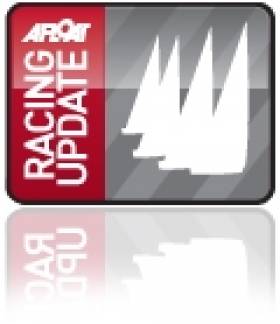Displaying items by tag: Ronan Cull
Cull Leads Howth Yacht Club Laser Frostbites
#laserfrostbite – Overall Ronan Cull has a safe lead with five firsts at Howth Yacht Club's Laser frostbites series, followed by Dave Quinn and Darragh Kelleher while it's a family affair in the other fleets; Aoife Hopkins leads the radial fleet, with brother Daniel leading the 4.7's.
Yesterday's fourth day of the winter series started in 12 knots of wind from the west, brilliant sunshine with a sharp chill in the air and a strong ebb tide. Twenty-six Lasers competed on Sunday with the welcome return of the handsome Dan O'Connell and the brave but injury plagued Dave Mulligan.
A slight starboard bias at the start of race 1 favoured Darrell Reamsbottom, Dan O'Connell and Ian McSweeney, but it wasn't long before Ronan Cull and Dave Quinn emerged to be likely leaders at mark 1. The fleet split, but those on the middle left, playing the shifts, got out ahead, with Cull, Quinn, Mike Evans, Ian McSweeney, and Darrell Reamsbottom rounding first. While Cull and Quinn were safely away, there was a good fight for the next slots between McSweeney, Evans, Reamsbottom, Darragh Sherdan, and O'Connell. McSweeney was able to defend 3rd until O'Connell took advantage of a left hand shift at the top of the last full beat. McSweeney got back at him by beating toward the finish line, but a poorly timed tack allowed O'Connell to squeeze in at the pin taking 3rd. Darragh Sheridan finished 5th.
Date: 23/11/2014
Wind: SW, 12-14 knots
Races sailed: 7 & 8, Olympic triangle followed by Windward/Leeward,
Race length: 40 min each
Leader, standard: Ronan Cull
Leader, radial: Aoife Hopkins
Leader, 4.7: Daniel Hopkins
Race 1 - Standard fleet:
1. Ronan Cull
2. Dave Quinn
3. Dan O'Connell
4. Ian McSweeney
5. Darragh Sheridan
Approximately 1 second elapsed between the last finisher of race 7, and the warning signal of race 8 – PRO Liam Dineen opting for a windward/leeward course, making for challenging and competitve downwind legs. Dan O'Connell was on the money at the pin with a slight port bias, and at one point it looked like he was going to cross the fleet. He tacked and led the fleet toward the left, in a strengthening ebb. There was plenty of jostling for position off the line, and the majority of the fleet hit the left layline early. Dave Quinn, Darrell Reamsbottom, and Ian McSweeney led around mark 1, having played it more safely up the middle left. The second round saw Cull taking a convincing lead (from 4th around the leeward), not missing a shift, or any extra breeze on offer as the wind abated. Dave Quinn fell back to fourth and to a battle with Stephen Quinn, leaving McSweeney and Reamsbottom to fight for 2nd. McSweeney got ahead on the last full beat, Reamsottom having gone too far left, and a closely fought run ended with Reamsbottom establishing an inside overlap in the zone at the last leeward mark. McSweeney got a lucky jump ahead at the critical moment and was able to sneak around ahead and in 2nd place. Cull was well ahead at this stage and a worthy winner once more. 4th was also hotly contested by the two Quinns. They had split up the final beat and coming to the line Stephen - on starboard coming from the right – forced Dave to duck, and be postally pipped.
Race 2 - Standard fleet
1. Ronan Cull
2. Ian McSweeney
3. Darrell Reamsbottom
4. Stephen Quinn
5. Dave Quinn
Howth Yacht Club Wins for Quinn, Cull In Laser Dinghy Frostbite Series
#lasersailing – Thirty seasoned Laser sailors were greeted with a Westerly at 8knots at Howth Yacht Club for the second race of the 40th Laser winter series, slightly calmer conditions than last week! The Race Committee had their work cut out for them as both the wind and fleet were making things difficult.
After a General Recall, the fluctuating wind delayed the restart and eventually stabilized from a SW direction. Taking no prisoners, the RC went with a Black flag and needless to say managed to catch one over the line early! Half of the fleet went left and the other right. Things started to get tricky at the top mark with the boats from the right just edging out those from the left. A bunch that included Daragh Kelleher, Ian McSweeney, Oliver Keenan, Ronan Cull, Dave Quinn and Mike Evans all rounded in quick succession. Those who stayed to the left of the run or up tide managed to make some good gains and round the LW mark in good position. Sailors jockeyed for position throughout the race as picking up the little puffs and shifts on the beat made for tight tactical racing.
Ronan Cull was the one and only sailor falling foul of the Black Flag, leaving Dave Quinn to take the bullet ahead of Oliver Keenan.
Race 2 got underway in lighter conditions after the wind veered back to the West. A clean start this time, and a last minute right hand shift biased the committee boat for the start. Some boats headed left, but the leaders came in from the mid-right once again! Dave Quinn and Troy Hopkins took the lead around the WW mark with the fleet in hot pursuit. Darrell Reamsbottom showed some great pace on the light air reaches to pull up to third by the Leeward mark, and eventually climbed to first early on into the second beat.
Heart Rates began to rise as the Race Committee shortened the course and sailors could see the finish line at the WW mark. The three boats left of centre were looking pretty good until Darragh Sheridan put in a "Brilliant Performance" (best of luck Daragh with the new book) on the last beat to throw the cat amongst the pigeons leading a bunch of boats in from the right in slightly better breeze. The wind died in the final third of the beat, and Ronan Cull showed good speed in the home straight to take the win. Closely followed by Oliver, Daragh, Darrell and Dave, who were only separated by a mere boatlength on the finish line.
Race 1 - Standard fleet:
1. Dave Quinn
2. Oliver Keenan
3. Ian McSweeney
4. Darrell Reamsbottom
5. Darragh Kelleher
Race 2 - Standard fleet
1. Ronan Cull
2. Oliver Keenan
3. Daragh Sheridan
4. Darrell Reamsbottom
5. Dave Quinn
Kiwi Makes Top Start at Laser Worlds
The strong tidal current and light and at times very shifty breeze proved to be the principal challenges on the first day of the Laser World Championships off Hayling Island. It left Irish Olympic campaigner James Espey in 52nd, the top third of the senior fleet. Ronan Cull is in 152nd and Paul McMahon is 157th in the 159 boat fleet.
For those sailors who had spent the preceding days, or – for some – weeks, learning venue's nuances idiosyncrasies it was intelligence gained about the tidal current which was of immediate value.
Racing Day 1 broke the pattern of blustery winds and intermittent rain which have prevailed through pre-championships training phase, replaced absolutely on cue by bluebird skies, summer sunshine and light to moderate mainly northerly breezes.
New Zealand's Michael Bullot, runner up at last year's World Championships in Halifax, Nova Scotia made the strongest start across the two testing opening races by posting a second and a first in the first of four days of scheduled Qualifying heats.
His early statement of intent saw the Aucklander ashore this afternoon with a lead of one point over Skandia Team GBR's Paul Goodison, the Olympic and defending World Champion who opened his regatta with third place and then won his second heat by a comfortable distance.
The shifting directions of the wind, oscillating through as much as 30 degrees at times in the Standard fleet's first race set the early test, but a big 50 degrees swing early in of the second contest, kept the racers and the race team on their toes; the second and third starts were delayed until the breeze settled.
According to Goodison patience was his key virtue through both races, waiting until changes in the breeze were sufficiently established enough to make a consideredmove, rather than falling to the temptation to try and benefit every small change.
And with up to a knot of current running and the direction of flow progressively changing, flowing to the NW at the start of Race 1 and moving to the NE tactical decisions were a movable feast, rich with opportunities to make gains and losses.
Australia's double world champion Tom Slingsby, who arrived late Saturday at Hayling Island fresh from winning the Etchells World Championships with America's Cup legend John Bertrand, showed no sign of ring rustiness when he won his first heat, but he admitted to trying to breaking from the pack's conventional thinking on the first downwind of the second race, and his error dropped him four boats to score an eighth.
Among those finishing their first day with results which were well ahead of their expectations were Nicholas Heiner who won the first heat for the Yellow fleet, the biggest senior triumph yet for the young Dutch sailor who seeks to emulate or better the record of his 1996 Finn Olympic bronze medallist father, whilst Estonia's Karl-Martin Rammo paired up a third and first to match the first day 4pts tally of Goodison.
In the Junior World Championships Italy's Francesco Marrai leads the 118 boat fleet after posting a second and third. Competing for Ireland are Chris Penney, Aidan McLaverty and Hammy Baker.
Laser World Championships, Hayling Island GBR,
After Day 1
1 Michael Bullot (NZL) 1,2, 3pts
2 Paul Goodison (GBR) 3,1 4 pts
2 Karl-Martin Rammo (EST) 3,1 4pts
4 Luka Radelic (CRO) 2,2 4pts,
5 N Thompson (GBR) 2,3 5pts,
6 Pavlos Kontides (CYP) 4,3 7pts
7 Tom Slingsby (AUS) 1,8 9pts
8 Matthias Del Solar (CHI) 4,5 9pts
9 Andrew Murdoch (NZL) 6,4 10pts
10 Giacomo Bottolli (ITA) 9,4 13pts
Junior World Championships
1 Francesco Marrai (ITA) 2,3 5pts
2 Lukas Feuerherdt (GER) 1, 5 6pts
3 Thorbjoern Schierup (DEN) 3,3 6pts
4 Bogoslav Bugarin (CRO) 8,5, 13pts
5 Antony Munos (FRA) 14,2 16pts
Paul Goodison (GBR): "The first race started off in a really shifty breeze, up to 12 knots but it dropped back to five or six knots with some big swings in the wind. I think it was a bit of a patience game waiting for the wind to come back. It can be too easy to go chasing things, but the wind usually came back and so that was a bit of a patience game.
The second race got super light just before the start but at the gun there was probably 10-11 knots, that dropped to about 4-5 knots, but there was nearly a knot of tide and so it was very important to stay inside the laylines with that much of tide running. Quite a lot of the fleet got outside the port tack layline which meant them reaching in and pushing tide and that hurt them quite a lot.".
" We had three great weeks of breeze at Sail for Gold and for the two weeks since, and so here today it has been nice to remember how to do it in the light winds."
"After Sail for Gold I did three days here and then arrived her last week and have been sailing most days since then."
Andrew Maloney (NZL): "It was pretty shifty. I got a good start at the pin and then got a nice left shift and so managed to cross the fleet and from there it was just about sailing on the lifted tack and staying in the pressure on the downwind legs. It sounds easy but it wasn't!
The start and the first beat were vital and when you were out in front it got easier.
I was second at the first mark. He got back into the second left shift half way up the beat and that made the difference."
Nick Heiner (NED): "I had a really good start at the pin end, five boats from the pin and got a nice shift to the left and from there on was always ahead of the fleet, and could play with the shifts. Downwind I was not that fast, but I managed to stay ahead. But now I know what to work on for the coming days. It was a good start.
I like it here, with the current and the waves it is good fun, a bit like home in Schevenigen where I have trained a lot."
Tom Slingsby, (AUS): " I always say you can't win the regatta on the first day but you can lose and I managed not to do that which is good. It was a very tricky day with a lot of current. I got through pretty well, not as well as some but I am pretty happy with my day.
I have to say I was feeling a bit rusty on the way out to the start. Everyone else was kind of cruising around and I was racing trying to get used to it, trying to get the feel back. But all in all I sailed fine.
The first race was light, six to ten knots, I sailed quite well and rounded second and slowly caught the leader to win. The second race I was about fourth or fifth. But with the downwind the current was washing us straight across the course, I decided to take a bit of a risk and not join the train as we call it, and I broke away and unfortunately it did not work, but it could have been worse."
Karl-Martin Rammo (EST): "It was the best day of my life so far, off the charts. I managed to get in the front of the fleet early. First race I had a mediocre start but got to the front of the fleet by just sailing the shifts, I was kind of the middle but just got it right. It was so shifty and gusty.
The second race I had a really good start at the pin and tacked immediately and went pretty much to the right corner and was ahead at the upwind mark, had a mediocre downwind mark but has a good second upwind."
Nick Thompson (GBR): "All in all it was a pretty good start In the first race it was very shifty, probably averaging 10-12 knots at times but with big changes in pressure but it was nice to race in with lots of opportunities to come back. The second race was tough with strong current running which really skewed the course too much, but the race committee did a good job in moving the windward mark to square it up and so it was a decent race."


























































